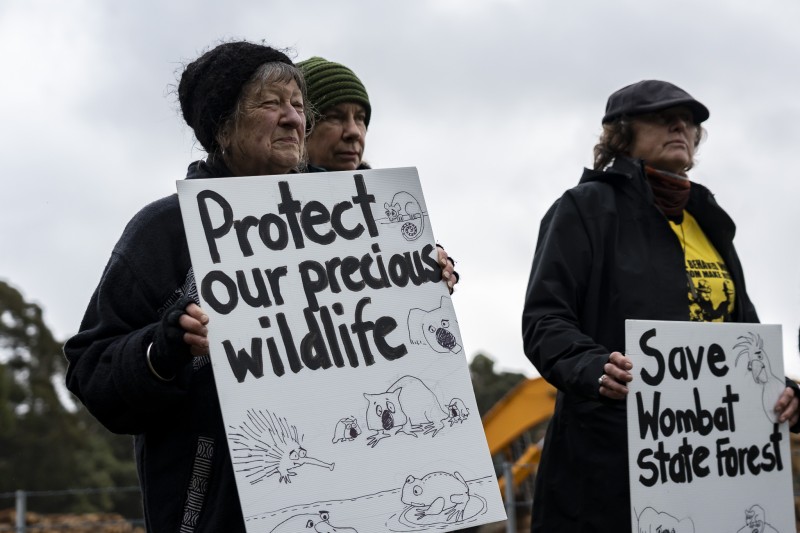
Members of the Wombat Forest community joined with Extinction Rebellion to draw attention to what they describe as environmentally damaging salvage logging in the Wombat State Forest.
Theatrics took place on the roadside at the Forest Fire Management Victoria log storage site near Daylesford last Tuesday. Large volumes of logs are stored from nearby salvaging operations.
Dressed in black mourning attire, this gathering grieved the recent forest destruction by FFMV salvage-logging works. Red Rebels silently communicated distress. After short eulogies, Red Rebels and some mourners visited the nearby forest coupe where many larger logs once stood tall.
In June 2021, a large storm impacted significant patches of Wombat State Forest bringing down swathes of forest. Roads and tracks were quickly cleared of fallen trees. From 2022 until its 2024 demise, VicForests intensively logged the nearby ‘storm-recovery’ areas. Vast volumes of timber were removed locally.
FFMV began ‘debris-management’ works in late 2023. FFMV repeatedly emphasised to local communities that its works were distinct from VicForests: no heavy machinery, taking only fallen logs and isolated hazardous trees, all works ‘non-commercial’ and low impact. FFMV continues to insist all work is to improve safety, for emergency access and fuel loads.
“There’s no timber harvesting or salvage logging taking place for a commercial purpose in Wombat State Forest,” said Chris Hardman, chief fire officer in a 2024 FFMV statement to ABC Ballarat.
Now, FFMV employs the same VicForest ex-employees and contractors. The same machines and log trucks remove vast volumes in the same forest as VicForests. There’s 6000 cubic metres of timber stacked in the log depot now, a fraction of the amount gone from Wombat this year, far above 4000 cubic metres sustainable timber yield. Satellite data adds to concerns that more than isolated standing trees are being taken. FFMV’s own fuel risk guide excludes logs. Community can see logging has more fine debris, more dense regrowth and increases fires risk for communities.
“Clearly, these salvage works are causing serious environmental harm. Soils are being compacted, young plants destroyed and future habitat for many species is being lost — all the while failing to mitigate fire risk,” said Gayle Osborne, convenor of Wombat Forestcare.
“We have had three years of unrelenting industrial-scale salvage of storm-thrown trees from the forest. At one stage there were 14 35-tonne machines removing large logs and compacting the soil.
“There are many reasons these logs should remain in the forest as a critical part of the ecosystem — to provide habitat for small reptiles and mammals, food for fungi and moisture retention to help keep the forest floor damp.”










